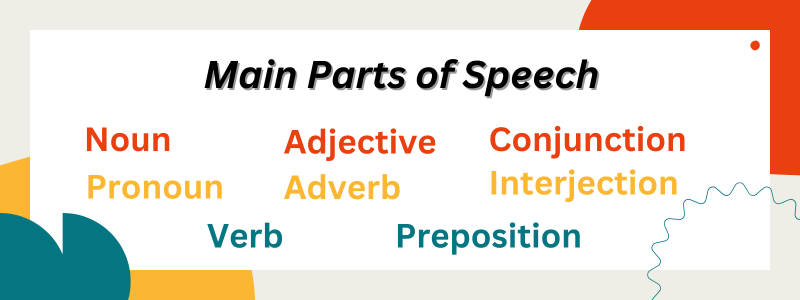Understanding Parts of Speech: Questions and Answers
Welcome to our comprehensive guide on questions on parts of speech! Whether you’re a student trying to ace your grammar tests or simply someone who wants to enhance your writing skills, understanding parts of speech is crucial. In this blog, we will tackle common queries related to parts of speech, providing clear explanations and examples to help you grasp these foundational elements of language. So, let’s dive in and explore some frequently asked questions on parts of speech!
Table of Contents
Parts of Speech
1. What exactly are parts of speech?
Answer:
Parts of speech are the different types of words categorized by their roles and functions within a sentence. The important parts of speech include nouns, pronouns, verbs, adjectives, adverbs, prepositions, conjunctions, and interjections. Each plays a unique role in sentence structure and meaning. Understanding these categories helps in forming grammatically correct and coherent sentences.
Main Parts of Speech
2. What are the main parts of speech?
Answer:
The main parts of speech are categories that classify words based on their role in a sentence. The primary parts are:

- Nouns: Words that name people, places, things, or ideas. Examples include “dog,” “city,” and “happiness.”
- Pronouns: Words that replace nouns to avoid repetition. Examples include “he,” “she,” “they,” and “it.”
- Verbs: Words that denote actions or states of being. Examples include “run,” “is,” and “think.”
- Adjectives: Words that describe or modify nouns. Examples include “blue,” “quick,” and “happy.”
- Adverbs: Words that improve verbs, adjectives, or other adverbs. Examples include “quickly,” “very,” and “loudly.”
- Prepositions: Words that show relationships between nouns (or pronouns) and other parts of the sentence. Examples include “Between,” “Under,” “at,” and “Before.”
- Conjunctions: Words that connect words, phrases, or clauses. Examples include “and,” “but,” and “or.”
- Interjections: Words or phrases that denote strong emotions or sudden exclamations. Examples include “wow,” “oh,” and “ouch.”
Function of Nouns in a Sentence
3. How do nouns function in a sentence?
Answer:
Nouns can serve as subjects, objects, or complements within a sentence:
- Subject: The noun that carries out the action described by the verb. For instance, in “The dog barks,” “dog” is the subject.
- Object: The noun that receives the impact of the action expressed by the verb. For instance, in “She built a sandcastle,” “sandcastle” is the object, as it is the entity that the action of “built” affects.
- Complement: The noun that gives more detail about the subject or object. For example, in “Her job is a designer,” “designer” is the complement.
Different Types of Nouns
4. What are the different types of nouns?
Answer:
Nouns can be classified into several types:
- Proper Nouns: Names specific people or places (e.g., “Alice,” “New York”).
- Common Nouns: General names for people or things (e.g., “city,” “dog”).
- Abstract Nouns: Names for ideas or concepts (e.g., “freedom,” “happiness”).
- Concrete Nouns: Names for things that can be perceived by the senses (e.g., “apple,” “book”).
Understanding these types helps in identifying and using nouns correctly, which is a key focus in many questions on parts of speech.
Different Types of Pronouns
5. What are the different types of pronouns, and how are they used?
Answer:
Pronouns come in various types, each serving a different role in language:
- Personal Pronouns: These represent individuals or entities, such as “I,” “you,” “he,” “she,” “it,” “we,” and “they.” They can function as the subject of a sentence (“She dances”) or as the object (“They called him”).
- Possessive Pronouns: These denote ownership or possession. Examples include “my,” “your,” “his,” “her,” “its,” “our,” and “their.” For instance, “That is our car.”
- Reflexive Pronouns: These refer back to the subject of the sentence, reflecting the action back to them. Examples include “myself,” “yourself,” “himself,” “herself,” “itself,” “ourselves,” and “themselves.” For example, “He made the cake himself.”
- Relative Pronouns: These introduce relative clauses and link them to nouns previously mentioned. Examples include “who,” “whom,” “whose,” “which,” and “that.” For example, “The artist who painted this is famous.”
- Demonstrative Pronouns: These specify particular items or individuals. Examples include “this,” “that,” “these,” and “those.” For example, “Those are my shoes.”
- Indefinite Pronouns: These refer to people or things in a non-specific way. Examples include “someone,” “anyone,” “everyone,” “nothing,” and “each.” For instance, “Anyone can join the club.”
Role of Verbs in a Sentence
6. What role do verbs play in a sentence?
Answer:
Verbs are crucial because they express actions, states, or occurrences. They determine the sentence’s predicate and indicate what the subject is doing or experiencing. There are different types of verbs:
- Action Verbs: Describe physical or mental actions. For example, “run,” “write,” and “think.”
- Linking Verbs: Connect the subject to a subject complement that describes or identifies it. Common linking verbs include “is,” “am,” “are,” “was,” “were,” and “seem.” For example, “She is a doctor.”
- Auxiliary (Helping) Verbs: Assist the main verb to form different tenses, moods, or voices. Examples include “have,” “will,” “can,” and “do.” For example, “She has been studying.”
How Do Adjectives Modify Nouns
7. How do adjectives modify nouns, and can you provide examples?
Answer:
Adjectives enhance nouns by adding detailed information about them, including their attributes, amounts, or conditions. This added detail helps clarify the noun in question. Here are some examples:
- Descriptive Adjectives: Provide insight into the attributes or features of the noun. For instance, in “The majestic mountain,” “majestic” gives more information about the mountain’s grandeur.
- Quantitative Adjectives: Indicate the quantity of nouns. For example, “Three apples,” where “three” specifies the number.
- Demonstrative Adjectives: Identify specific nouns by pointing them out. For example, in “This House,” “this” directs attention to a particular house.
Function of Adverbs in a Sentence
8. What is the function of adverbs in a sentence?
Answer:
Adverbs enhance verbs, adjectives, or other adverbs by offering extra details about the manner, timing, location, or degree of an action or quality. They answer questions like “How?” “When?” “Where?” and “To what extent?”
- Modifying Verbs: For example, “She sings beautifully,” where “beautifully” describes how she sings.
- Modifying Adjectives: For example, “He is very tall,” where “very” intensifies the adjective “tall.”
- Modifying Adverbs: For example, “He runs extremely quickly,” where “extremely” enhances the adverb “quickly.”
Function of Prepositions in a Sentence
9. Can you explain how prepositions work in sentences?
Answer:
Prepositions show relationships between a noun (or pronoun) and other words in a sentence. They often indicate time, place, direction, or manner. The noun or pronoun following the preposition is known as the object of the preposition. For example:
- Place: “The cat is under the table,” where “under” shows the relationship between “cat” and “table.”
- Time: “We will meet at noon,” where “at” indicates the time.
- Direction: “She walked to the park,” where “to” shows the direction.
Use of Interjections in a Sentence
10. What are interjections, and how are they used in writing?
Answer:
Interjections are words or expressions used to convey intense feelings or spontaneous reactions. They are often standalone or set off by punctuation like commas or exclamation marks. Interjections can convey feelings such as surprise, joy, or pain. Examples include:
- Surprise: “Wow! That was amazing!”
- Joy: “Yay! We won the game!”
- Pain: “Ouch! That hurt!”
Interjections add emotional emphasis and can vary in formality
Importance of Parts of Speech
11. How can understanding parts of speech improve writing and communication?
Answer:
Understanding parts of speech enhances writing and communication by:
- Clarifying Sentence Structure: Knowing how different words function helps construct clear and grammatically correct sentences.
- Improving Word Choice: Understanding roles of words helps in selecting the most precise word to convey meaning.
- Enhancing Style and Variety: Effective use of different parts of speech can vary sentence structure and style, making writing more engaging.
- Avoiding Errors: Recognizing parts of speech helps in avoiding common grammatical mistakes and improving overall accuracy.
Conclusion
Grasping the parts of speech is fundamental to mastering grammar and enhancing communication. Each part plays a distinct role in sentence construction, contributing to the clarity and effectiveness of our language use. By familiarizing yourself with these categories, you can improve both your writing and speaking skills, making your communication more precise and engaging.

